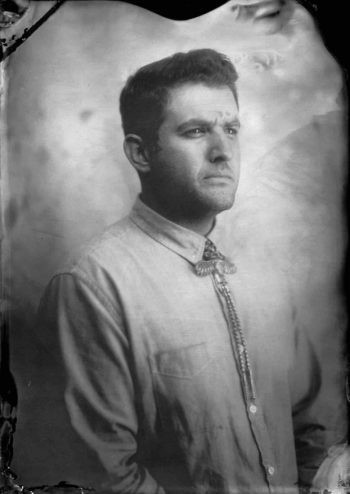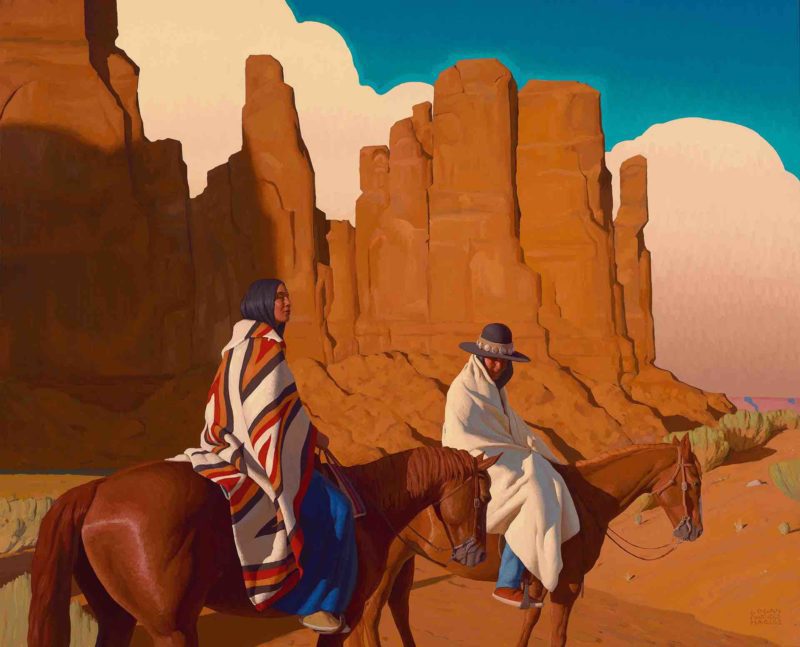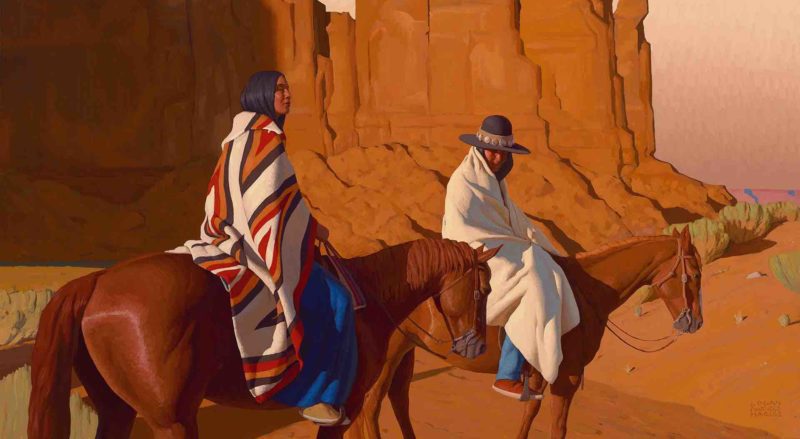INTERVIEW: Artist Logan Maxwell Hagege, and the images burned into his head

The American West, both its culture and its landscapes, have inspired artists for hundreds of years. Whether it’s dreamy scenes from the tranquility of the desert or depictions of the abundant wildlife, the expansive land between the Pacific Ocean and Rocky Mountains has offered a continuously engaging frame of reference.
Logan Maxwell Hagege, a Los Angeles artist, has similarly been inspired by his travels in southern California and throughout the Southwest. His artwork, often selling for tens of thousands of dollars, is currently on display in the Masters of the American West show at the Autry Museum of the American West in Los Angeles.
Hagege’s oil on canvases, sometimes as large as 68 inches in length, depict scenes and landscapes from his travels and memories. “Where Land Meets Sky,” for example, features two Native Americans on horseback, one looking down in deep contemplation, the other searching the horizon. Behind them and their steeds is a sculptural castle of red rock that wouldn’t be out of place in Monument Valley.
“A Day in the West” has a cowboy holding on tight to a bucking horse. The man’s left hand is in full grip mode, while his right hand holds one of the most iconic of western images: a cowboy hat. The background, in different shades of beige and red, consists of clouds and rock formations that could be the Red Cathedral in Death Valley National Park.
For Hagege, his fascination and skills in fine art began at a young age when he took to comic books and cartoons.
“I think as a kid the focus was, like most kids, comic books, cartoons, animation, that sort of thing, so I think that was my dream to either be a comic book artist, illustrator or work in animation,” Hagege said in a recent phone interview. “Then that actually sort of happened. After high school, I was going to college and then started working as an intern at a cartoon studio, and then I was hired there eventually as a paid gig. But I just wasn’t crazy about it, and at the same time, I was going to art school and really fell in love with traditional drawing and painting. And that just led me into the fine art world from there.”
Hagege has been working for the past 16 years as a professional fine artist, and he commands relatively steep prices for his oils on canvas. “The Heart of Everything,” which measures 68 inches by 54 inches, sold for $68,000.
When Hagege looks at his creations, he sees an evolution of style and subject matter. “There was some experimentation with different subjects, and then once I started painting the Southwest, I think the subject sort of lended itself to the way I paint and to the way I see it,” he said. “There are a lot of big shapes, big simple shapes. Certainly that’s the way I see the desert. There are people that see it differently, but that was really the way I saw it. I saw it as these really simple big shapes, and I always had a simplified, modernist way of seeing things and working.”

Each of the subjects in Hagege’s canvases are based on real people. The landscapes are sometimes based on actual scenes that he has seen, but other times they are composites of memories from his travels.
“Usually there’s an element of a place that I’ve been or seen in the paintings, but there’s also quite a bit of imagination that comes into play,” he said. “To me, the paintings feel like memories. They’re like these images that have been burned into my head, so I don’t have a photograph of something and then paint it exactly as it is in the photo. I’ll use a photo for some portion of the painting, and then my memory for another portion, and then maybe a drawing or a painting that I did on location as reference for another portion of the painting. It’s a composite really of memories and images, things that I’ve seen, things that are imagined as well.”
In many ways, Hagege’s depictions are poetic, reminders of cultures and landscapes that have been forgotten or lost in the increasingly hectic world of the 21st century. They are simultaneously timeless and of the minute, a challenge to the viewer to place the scene in an historical context or find a connection to modern society. The Autry describes his paintings this way: “Hagege’s subjects are contemporary American Indians living in the Southwest as well as modern landscapes that are timeless both in life and in his works. His evolution from landscape to figure — and now a combination of both — was a natural progression in his art that he continues to push to its limits in his own unique style.”
“I’ve seen so much change even just here in southern California,” he said. “Areas I used to go and paint landscapes are now housing developments. There’s really great landscapes that are just gone. … I don’t think I really read into it that much myself as far as the people are concerned. I think, for me, it’s more of a personal experience where it’s a portrait of a person that I know and not so much the people as a whole, so I guess I’m documenting more the person than I am making a statement.”
The fact that Hagege now has his work in the Autry, both the permanent collection and the Masters of the American West show, is a full-circle moment. He used to visit the museum on field trips as a child, so the first time he saw one of his paintings on those hallowed walls was quite surreal.
“They’ve been very supportive, and it’s pretty neat I think,” he said. “I think three or four of my paintings are in the permanent collection of the museum now, so that’s pretty wild to me.”
The Autry awarded him the Don B. Huntley Spirit of the West Award at the 2016 Masters of the American West show, and in both 2014 and 2015, he won the Gene Autry Memorial Award. He has paintings in the permanent collections of the Bone Creek Museum of Agrarian Art, Booth Museum, Briscoe Western Art Museum and Eiteljorg Museum of American Indians and Western Art, among others.
The constant painting keeps Hagege a busy man. “Little things like keeping your deadline straight, making sure your frame is ordered on time, the right supplies for things that are coming up, and, of course, you have to keep track of paintings and inventory,” he said. “It’s a whole other side of the business that I never really knew about. No one really talked to me about it, so I just have had to figure it out on my own. Luckily, I have bookkeepers and accountants that really help me because I don’t have that sort of mind, so it’s great to have other people that can help me out with that sort of stuff.”
Viewers of Hagege’s artwork will likely see a unique style, one that has similar features across the many canvases. For the artist, this is indicative of his current period, but he doesn’t feel locked in to any particular iconography. He’s constantly evolving.
“I think it’s always a period wherever I am,” he said. “If you were to look back at the evolution of the last 16 years or so, the work has evolved and changed quite a bit even in the last five years, so I don’t really think of that. I don’t think of being stuck painting one subject or one style. I just kind of go one painting to the next. It’s the mood that I’m in that day. It’s the feeling I have that day of something that I feel like painting, and that’s really always served me best. … I got into this line of work because I wanted to just really paint what I felt like painting. If paintings stopped selling tomorrow, I’m still going to be doing what I’m doing. It’s great that I’ve been able to make a living at it, but I’m going to keep doing this no matter what.”
He added: “I think longevity lends itself to artists that are willing to experiment and grow, and generally your audience will grow with you. I look at people even outside of the art world. If you look at a musician like Bob Dylan. I mean, he’s been all over the place from folk to rock to more country, blues, just all over the place. I think that’s really a neat thing to be able to do with a career. For me, I just like to have fun with it and enjoy what I’m doing, so I just have to follow my instincts.”
By John Soltes / Publisher / John@HollywoodSoapbox.com
Logan Maxwell Hagege’s paintings are currently on display in the Masters of the American West show at the Autry Museum of the American West in Los Angeles. Click here for more information and tickets to the Autry. Click here for more information on Hagege.

